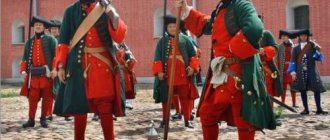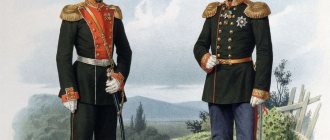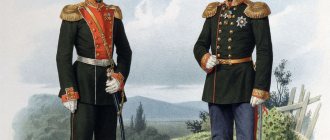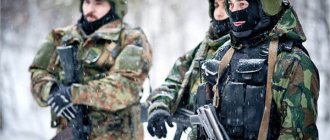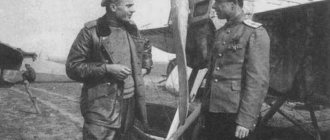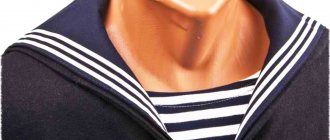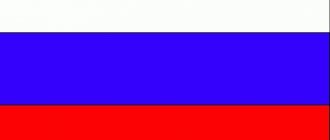White dress uniform of sailors
The color of the sailors' uniform changed several times, as did the uniform itself. All elements, their color, cut were selected taking into account practical qualities, convenience, and also within the framework of following certain canons. Lightweight canvas was considered the optimal material until the 80s and was actively used within the Russian fleet due to its convenience and practicality.
But was the shape always like this, and what colors were used in the past? Which of them remain relevant today, and why is the dress uniform always white?
Three stripes on the butt
Currently, flannel uniform shirts, which are used to support the modern fleet, are blue, and summer cotton uniforms are white (with a blue jacket edged with three white stripes).
The uniform collar is part of the ceremonial uniform of enlisted personnel of the Navy and is worn with a flannel or uniform.
A uniform collar is also called a collar.
This is interesting: Interesting case
Collar as an important form attribute
You should know that the collar has a symbolic meaning. It consists in the fact that there are three white stripes on it. They are a symbol of the victories of the Navy in such battles:
- Chesmenskoe.
- Gangutskoe.
- Sinopskoe.
The collar material is cotton. It has a lining. The collar is worn over the shirt. The Navy dress uniform includes a collar as part of its kit.
Why do sailors have white dress uniforms?
Two shades are considered traditional for sailors: white and blue. It is no coincidence that the dress uniform is white. For Navy personnel, it is considered very symbolic. Achromatic tone is associated with sea foam, clouds, breakers and blocks of ocean ice. Even on land, putting on a ceremonial uniform, military personnel keep in their hearts memories of the open spaces of the sea and snow-white clouds. In addition, a suit of this color looks very solemn.
@cont.ws
About fabrics
Until the 80s, military everyday work uniforms for military personnel Navy were made of lightweight canvas, which was easy to clean from the most difficult stains. The Black Sea Fleet was dressed in white work clothes, the rest were most often blue. A little later, the color of the uniform changed to blue/dark blue, and the material became predominantly cotton fabric . The new uniform is sewn in a variety of studios, using all sorts of and not always high-quality materials. The new (currently approved) uniform can be of any color ranging from shades of black and blue. A good suit from a petty officer - thick, dark material.
Literary version
...It was a dark night... Our young cabin boy, after his rescue on the water, could not sleep. Jumping out onto the deck, he saw the boatswain smoking his pipe in the stern.
- Well, young man, can’t sleep? It’s been a long time since there was a command “All clear”?; The boatswain looked at him questioningly.
- No, I can’t sleep!; answered the cabin boy.
- I would like to thank you for saving me!; the cabin boy blurted out warmly and gratefully. You pulled me out of this sea!
- I didn’t pull you out of the sea, but from the other world!; answered the old sailor.
By the way, why are you not dressed in uniform? Where is your guy?
Hanging his head, our cabin boy found himself:
- I washed it this very minute!
After a while, he came running back, carrying his dick in his arms.
- Well, that’s commendable! Do you know what this is?; asked the boatswain.
- I just heard that this is a collar... But still, what is this, comrade boatswain?
He chuckled contentedly and invited the cabin boy into his cabin.
- Well, sit back and listen!
Young turned all out loud.
Here's what the boatswain said:
There are several stories and legends about the appearance of 3 stripes on sailors’ legs, or as you put it – collars.
At first, in the distant past, on ships, these were indeed collars that were used to protect the backs of rowers from the scorching rays of the Sun and splashes.
The collar also, much later, first appeared as a lining under the hair, protecting the uniform from “powder” falling off the wig, in foreign navies.
After the abolition of wigs, a square cloth collar was used for insulation - in cold windy weather it was tucked under the visor and replaced the cap.
Another legend tells that these three stripes appeared with the appearance of three squadrons under Peter I. It was in honor of these squadrons that three stripes appeared on the guy.
Also, there was a story about three victories of our Fleet, in honor of the three stripes on modern jacks - at Gangut in 1714, Chesma in 1770 and Sinop in 1853.
That is, these victories really took place, but they relate to stripes as a method of patriotic education.
However, guy is, first of all, a FLAG, my friend!
From the Dutch, “guys” is a naval flag, as well as the flag of coastal fortresses. It is raised daily at the bow (on the flagpole on the bowsprit) of ships of the 1st and 2nd ranks, exclusively during anchorage, along with the stern flag, usually from 8 a.m. to sunset.”
- But, comrade boatswain, why hang a flag, or jack, on the bowsprit? the cabin boy was perplexed.
- And then, my friend, that this flag designated the ship’s home port!; answered the boatswain.
Historical version
The collar was first introduced in the Russian Navy in 1843.
The origin of the collar has a very interesting history. In those days, sailors wore wigs and oiled horsehair braids. Braids stained clothes, and sailors were punished for it, so they came up with the idea of wearing a leather flap under the braid. Braids have not been worn in the navy for a long time, and the leather flap has turned into a blue collar. There is another version: to protect against sea spray and wind, sailors wore a hood, which later transformed into a collar.
The uniform collar is made of dark blue cotton fabric, with three white stripes along the edges. Blue lining. At the ends of the collar there is one loop, in the middle of the neckline there is a button for fastening the collar to the uniform and working naval jacket.
Starting with Peter I
Peter I had three squadrons in his fleet. The first squadron had one white stripe on its collars. The second has two stripes, and the third, who is especially close to Peter, has three stripes. Thus, the three stripes began to mean that the naval guard was especially close to Peter. At the same time, the first squadron wore white flannel uniform shirts, the second squadron had blue shirts, and the third - red.
First the guard
In 1881, three white stripes were introduced on the collars for sailors of the Guards Fleet Crew. And the next year, 1882, this collar was extended to the entire fleet.
The stripes on it signified organizational affiliation. The Russian Baltic Fleet at that time was divided into three divisions. At the same time, the sailors of the first division wore one white stripe on the collar, the sailors of the second division - respectively, two stripes, and the sailors of the third - three.
Fleet victories have nothing to do with it
It is widely believed that they were introduced in memory of three victories of the Russian fleet:
- at Gangut in 1714;
- Chesmy in 1770;
- Sinope in 1853.
But it turns out that this is nothing more than a beautiful and highly patriotic legend.
There is no doubt that the number of stripes has nothing to do with the victories of the Russian navy. It’s just that when choosing a design, the purely aesthetic side of the matter prevailed: the collar with three stripes turned out to be the most beautiful and has a simple, finished shape. In the summer, sailors in our navy wear a white linen uniform shirt with the same attractive blue collar, edged with three white stripes. The same three stripes are on the blue cuffs of these shirts.
Dress cap of the USSR Navy
Trousers of an employee in the navy. New Navy uniform
When sewing trousers, the cut that was used in the seventeenth century is still used. The material for sewing these pants is dark blue and has a cotton base. The main features of sailor trousers are pockets. They are located on the sides. There are also special fasteners on the codpiece. In addition, there is a belt with loops. They are called “loop loops” and hold the belt. The form's belt is made of leather. It has a plaque with state symbols. Now it shows the emblem of the Navy. Previously, in Soviet times, an anchor and a star could be seen on the plaque.
What colors and types of uniforms are used in the navy?
Sailors are, first and foremost, military personnel. Therefore, as in other branches of the military, they have a clear hierarchy. Depending on the position, the naval suit varies.
Thus, the sailor's uniform, as well as the clothing of the cadets, consists of a white shirt, trousers, collar, shoes and headdress. The entire suit is made in blue. The collar is decorated with white stripes.
The clothing of officers and midshipmen includes the following elements:
- wool cap;
- uniform jacket;
- coat;
- cream shirt and tie;
- trousers with belt;
- shoes;
- scarf and gloves.
All clothes, except the shirt, are made in a laconic black tone. Moreover, officers are allowed to wear a sweater, jacket, cap and jacket.
Girls in the navy wear a woolen skirt, a cream-colored blouse, a jacket, a gold-studded tie and shoes. The sailors' uniform is predominantly black. Even on the hottest day, girls are required to wear nude tights. In winter, the uniform set is complemented by a woolen coat and muffler. You are also allowed to wear a hat with earflaps and a sweater.
Ceremonial sets
There are several of them too.
The fundamental difference is the color. Black and white are the two colors allowed in the Navy. A gold-studded tie is required. The basis of any dress uniform is black trousers, a white shirt and a gold belt.
The petty officer and sailors wear a traditional striped vest. The headdress is a capless cap in summer and a hat with earflaps in winter.
The women's version of the "paradka" also almost completely imitates the everyday one. The only difference is that the festive costume is equipped with a gold belt. The jacket and scarf are white.
The white dress uniform of sailors looks very beautiful and solemn. But unfortunately, they may not demonstrate it as often as they would like!
School uniform rating for boys
How to choose a highlighter for the face
Did you like it?
This is interesting: The most expensive perfumes in the world
Sailor casual uniform
What is the most common new naval suit for the current year 2015? Navy suit , or in the jargon of Navy personnel , a work dress (also a sailor's robe) is a form of work clothing for sailors, cadets of naval schools, as well as petty officers Navy . Since 2014, the dress has been called a tunic. The costume consists of the following items of clothing:
- Shirt.
- Trousers .
- Sailor collar.
- Shoes .
- Headdress.
Shirt
The shirt, worn, as a rule, with a special button-down collar, is cut on the model of an old sailor's shirt. Its back and front are one-piece without seams, with a wide turn-down collar. There is a patch pocket in front, and an internal pocket on the reverse side. There is a slit that fastens with a button. The shirt sleeves are straight, set-in; simple shoulder straps corresponding to the rank of the wearer of the uniform. A mandatory element of sailor clothing is a white tag with an indelible combat number. Such a shirt is worn untucked, and during service on watch it must be tucked into the pants. In cold weather, an overcoat, peacoat or coat .
Trousers
work trousers retained the tailoring and style of the 17th century. Sewn from dark blue cotton fabric. They have side pockets, fasteners located on the codpiece, as well as a belt with special loops (belt loops) for a belt . The belt is made mainly from pigskin, and on its plaque is the emblem Navy . The buckle of the model that existed in the USSR depicted an anchor with a star.
Collar
The collar is also made of cotton material, worn over the shirt, has a lining and three white stripes, symbolizing the victories of the Navy in such battles as Chesme, Gangut and Sinop. Dress naval clothing also includes a sailor collar.
Headdress
Navy uniforms . One of them is a trump cap , to which is attached a ribbon with the name of the ship or with the inscription “Navy”. The tape is put on the band. It, like the bottom and walls, is made of wool. On the crown of the headdress there is a cockade , which is a golden anchor. In the USSR, the cockade was a so-called crab - a red star framed by golden leaves. The summer cap is made of white fabric (comes with a replaceable cover). The winter headdress is a black fur hat with earflaps .
In 2014, plans were made to introduce a wool hat to replace the earflap hat for outdoor work. Also in 2014, other developments of a new form were carried out, but some innovations did not take root.
The casual uniform set also includes a beret .
The set of hats also includes a cap . On the sides of the headdress there are three blocks, holes intended for “ventilation”. On the front side of the cap there is a golden cockade depicting an anchor. In the Navy of the USSR era, the cap was intended to be worn by the personnel of submarine vessels. It was black in color and varied in type, both for the rank and file and for the officers. Relatively recently, it began to be intended for wearing by the entire Navy . The semicircular style was replaced with a rectangular one. The cap also received white piping, which was previously intended only for the heads of a midshipman and an officer, as well as a cockade instead of a star.
Shoes
The above-described suit is accompanied by boots made of yuft leather, with thick soles, also called burnouts or bastards in naval jargon. Not so long ago boots were made with laces, but now, in 2015, they also have rubber inserts (they were introduced in 2014). For old-timers, it is preferable to wear dress shoes - boots made of leather tanned in chromium salts, in other words, chrome boots . In areas where the climate is harsh, military personnel wear cow boots . The tropical uniform includes wearing sandals.
Also included in the full set of everyday uniforms is vest , gloves and a hat with earflaps .
Have sailors' dress uniforms always been white?
This color of naval clothing was approved in 1951 and has remained virtually unchanged since then. For more than half a century, navy personnel have been wearing dress uniforms in two tones: white and black. The light model is intended for special occasions and is worn no more than twice a year.
In some naval units, white uniforms are worn daily. Regular employees are required to wear light-colored clothing so that their activities are visible. In addition, this color does not fade and does not heat up even when working for many hours in the scorching sun.
Reference. In pre-war times, the ceremonial uniform differed from the ordinary dark blue only in gold shoulder straps. Navy uniforms are very traditional and rarely undergo any changes.
Thus, the white “parade” in the navy is considered natural. Of all the statutory tones, this is the most festive and beautiful.
Dress uniform for petty officers, sailors and women
The Navy uniform for these categories includes a striped vest or cream shirt with a tie (this applies to contract soldiers), black wool trousers (for women - skirts) and a belt. A summer white cap, a black woolen hat or earflaps are put on the head. There is a white uniform or a blue flannel jacket (contract soldiers wear a jacket made of black wool). In the Navy, the parade uniform includes a woolen black coat, on which shoulder straps, mufflers and gloves are worn. Pea coats are also allowed. Petty officers, sailors and women wear ankle boots, boots or low shoes on their feet. The ceremonial belt for men is black, for women it is golden. There is also a demobilization uniform; it is divided into two types - strict and decorated. The strict uniform includes a sewn jacket, on which are the emblems of the military troops, aiguillettes, gold buttons, awards and badges, shoes, a belt and a beret. The decorated uniform has a free format, designed for the ingenuity of the demobilization.
Why do sailors wear a visor - what does it symbolize?
Someone may say, since they wear it, therefore the CHARTER requires it, serve, and don’t ask stupid questions. In fact, everything is much more interesting. It’s not for nothing that on Navy Day, everyone who is involved in the sea wears not only vests, but also sailor caps, because they symbolize a person’s involvement in naval service, in sailing on ships on the seas. All these people are proud of their life on ships, their service, and until the end of their lives they will keep their naval cap, which is decorated with ribbons with anchors, as a memory for their children and grandchildren.
The first caps
The sailors' headdress went through a long and rather thorny path before it turned into the very familiar cap. Let's try to trace it.
Initially, the Moremans acquired a soft hat with a brim. These hats were lying around, as were felt boots made of wool. This hat was introduced into the naval uniform at the very beginning of the 18th century. It was a very comfortable and simple headdress. The sailors, with such a hat, looked more like a peasant. For more than one hundred and fifty years, such headwear was part of uniforms. Of course there were some changes.
The end of the nineteenth century was marked by the introduction of grenadiers into the navy, by order of Emperor Paul I. This is a very bulky piece of clothing. This hat was about thirty centimeters high. Another headdress was introduced - a shako. And he was uncomfortable too. Imagine that you are wearing a small bucket on your head that expands towards the bottom. So imagine how such decoration on the head prevented the sailors from performing their main task, restricting their movements.
Around the beginning of the 19th century, the first cap appeared. As part of military formations, the position of forager is introduced. This is a special person who must store food for the mounted troops. They were worn by foragers - forage hats that looked like a cap with a pointed top. Approximately in the center it was bent in half and looked like a modern cap.
Ribbons on caps
As time passed, the cap hat changed its cut and gradually became similar to the cap of our days. Since 1811, this cap has become everyday wear in both the army and navy. But Mediterranean fishermen taught sailors how to attach ribbons to their caps, to whom relatives and friends gave ribbons. Prayers were embroidered on ribbons when they went to sea on their sailing ships. Initially, hair was tied up with ribbons, with the hope that now higher powers would protect it.
Sailors did not wear ribbons on warships until 1806. The tradition of wearing ribbons was started by the sailors of the English captain Brisbane during the siege of the Dutch fortress.
Tapes also have a practical side. She can fasten her cap in the wind and keep it. If a cap was found on the water, this meant that its owner had died.
In the Russian fleet, ribbons were first introduced in 1857. Until that time, only letters and numbers were cut out, they were painted over, or yellow cloth was placed under them.
Sailor's headdress - cap
It should be said that the uniform has several hats. First of all, it’s worth mentioning a cap without a visor with a ribbon. There is an inscription on the ribbon. It may say “Navy” or the name of the ship. The tape is fixed on the band. The bottom, walls and band are made of woolen fabric. The cap also has a cockade. It is located on her crown. The cap's cap badge is presented in the form of a gold-colored anchor. During the Soviet Union, it was made in the form of a red star, which was framed by golden leaves. This cockade was called a crab. The cap is made of white fabric. It has a replaceable cover.
Accessory Features
A beret is a soft headdress that does not have a visor. In the Middle Ages, it was worn not only by ordinary people, but also by monarchs. By the 20th century, headdresses began to be widely used as an element of military uniforms in many countries around the world. In Russia, it is worn not only by marines, but also by representatives of other units, as well as patriotic organizations. These hats differ in color:
- blue ones wear airborne forces;
- blue - Air Force;
- cornflower blue - FSO and FSB special forces;
- gray – Russian Guard;
- green – Border troops, FSSP special forces;
- olive - Russian Guard and special forces of the Main Directorate of the Ministry of Defense;
- orange – Ministry of Emergency Situations;
- maroon - special forces of the Ministry of Internal Affairs;
- red - military police.
The marine beret for officers was made of wool, and for conscript sailors and sergeants - from brushed cotton fabric. Its side was trimmed with leatherette; initially, a small red flag with a golden anchor was attached to the left side. On the front of the black beret was a scarlet star for sailors and sergeants, and for officers - the emblem of the navy.
It is interesting that after the parade, which was dedicated to the next anniversary of the October Revolution, it was decided to move the red flag from the left side to the other side of the beret
This was done so that the country's leaders and honored guests, who stood on the podium to the right of the military personnel, would pay attention to him. Changes were made to the charter
Active military personnel who wore the Marine beret noted its obvious advantages. The leatherette rim helped to hold the headgear securely even in extreme situations. The woolen fabric from which berets for officers were made was guaranteed to prevent hypothermia.
History of naval dress
the Navy uniform dates back to the time of Peter the Great. By order of the powerful emperor-manager, in 1696 the Boyar Duma decided to create the first navy in the Russian state. October 30 is traditionally considered the Founding Day of the first Russian Fleet.
With its creation, Peter I introduced for sailors and representatives of the lower ranks a uniform created from items of naval clothing of Dutch naval employees, namely a gray or green jacket made of coarse wool, short green pants, stockings and a wide-brimmed hat. shoes served as footwear for naval employees . The uniform was also replaced by a work suit for every day. It included a loose shirt, canvas trousers, a cocked hat and a camisole. The sailors wore it during Ushakov’s Mediterranean campaign.
A work uniform, which included a set of gray canvas trousers and a shirt, was worn during any ship work, over which a uniform snow-white shirt with an azure collar was worn. This suit was approved as a uniform for privates in the summer of 1874.
Main details
The naval uniform, of course, presupposes the mandatory presence of this headdress. First of all, it is a serious attribute of power over the elements, control of the ship, and authority among the captain’s subordinates.
Marine uniforms withstand a wide variety of weather conditions. And the cap, of course, also becomes the ship’s owner’s faithful companion.
Its main elements include a cockade, band, crown, piping, welt and visor. Also, the attribute must have a special insert made of a steel hoop. While wearing it, it allows you to maintain and maintain the shape of the headdress.
Dembel uniform
The demobilization naval uniform is a very special uniform for an employee. This is not a simple set of clothes - it is a manifestation of the imagination and pride of a soldier. Such a set is issued at the request of the employee. The tradition of making uniforms specifically for transfer to the reserve came to us from the USSR.
The demobilization form can also be divided into several types:
- Strict.
- Decorated.
The decorated demobilization uniform can, in turn, be unofficially divided into:
- Moderately decorated.
- Medium decorated.
- Richly decorated.
Accordingly, it makes sense to consider in more detail the strict (statutory) demobilization uniform, due to the freedom of compiling a set of decorated uniforms. It most often consists of a sewn jacket, with sewn emblems of the tribal troops, gold buttons, aiguillettes, pinned awards and badges, and traditional shoes, a belt and a cap (beret).
Marine cap: a little history
So, more details. A naval cap is an ideal option for those men who, from early childhood, dreamed of becoming captains of large ships. If you suddenly managed to try on such a headdress, happiness literally knew no bounds.
And the naval cap has changed more than once since the time of Peter the Great. This accessory appeared in the pre-revolutionary fleet back in 1812. The headdress was dark green, equipped with a black lacquered visor and three white edgings. Seventy years later, the cap changed its color to black. After the February Revolution, the attribute was transformed into a soft cap of the French type with a straight visor and a gold cord. The cap appeared in the Russian tsarist army thanks to Paul the First.
Features of the female form. What is she like?
The women's uniform includes a cap, which is made of black woolen material. In addition, the uniform consists of a black wool skirt, a cream-colored blouse, and a black tie with a gold-plated bartack. Also, a women's costume involves wearing a belt, black shoes or boots and tights. Tights must be nude. Women also wear a jacket.
In the cold season, the women's uniform includes a black astrakhan beret, a woolen coat, and gloves. Shoes change to boots. If the climate is not very harsh, you can wear boots. It is allowed to wear a sweater, a hat with earflaps, a raincoat and a cap.
Care Tips
For Marines, the black beret is considered a basic headdress that they must treasure and take care of. It is unacceptable for a fighter to treat him negligently, as this will immediately affect his entire appearance. In order for the beret to sit beautifully on the head, it must be processed. There is a fairly simple method: the product is soaked, then ironed, steamed, and beaten along the edge with a hammer. There is also a more complex method of care, more reminiscent of a ceremony:
- First, carefully rip out the lining.
- Place the beret in hot water for a few minutes and then squeeze it out.
- Place it on the head with a cockade inserted.
- Carefully give it the desired shape in front of the mirror, pressing in the necessary places.
- They fix it precisely by tightly rubbing shaving foam directly into the fabric. They do this without removing the beret from their head. After final drying, it will no longer lose its shape.
- To make the headdress smooth, it is shaved with a machine, removing the pellets.
- The inside is treated with hairspray so that it retains its shape for a long time.
A woolen beret can only be washed by hand, otherwise the product will become deformed. It is recommended to use baby soap or shampoo, and best of all, liquid powder intended for delicate fabrics. Wash it at a temperature of 30 to 40 degrees. After gently squeezing, the product is pulled onto a round surface of appropriate size. After a few hours, when it dries, fix the shape and dry it completely. It is advisable to store the headdress flattened and in a dry place. It is not recommended to leave the product exposed to direct sunlight for a long time.
